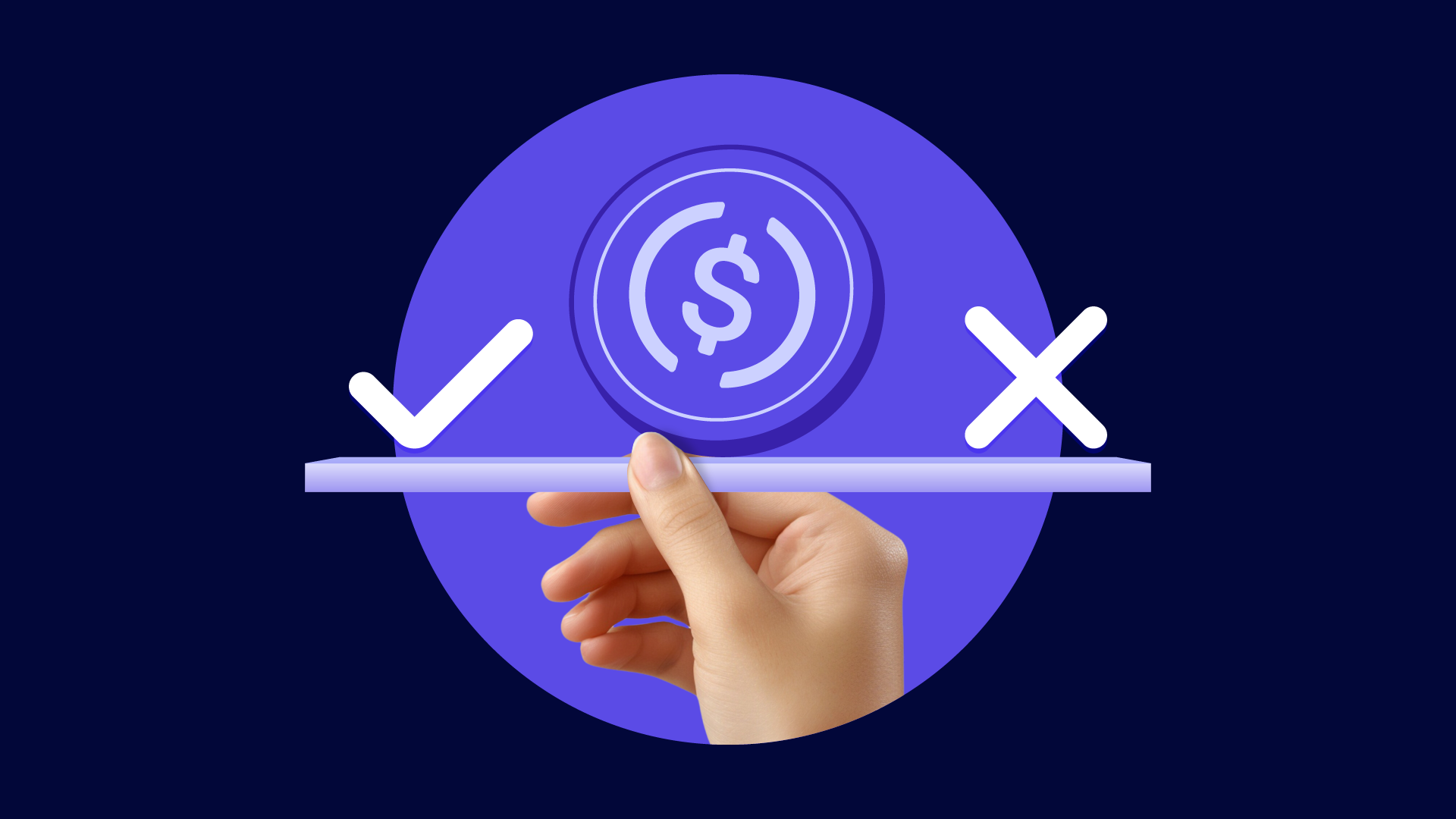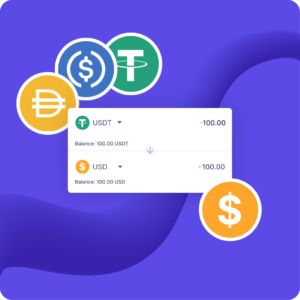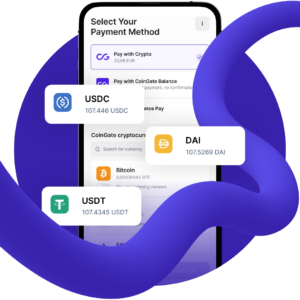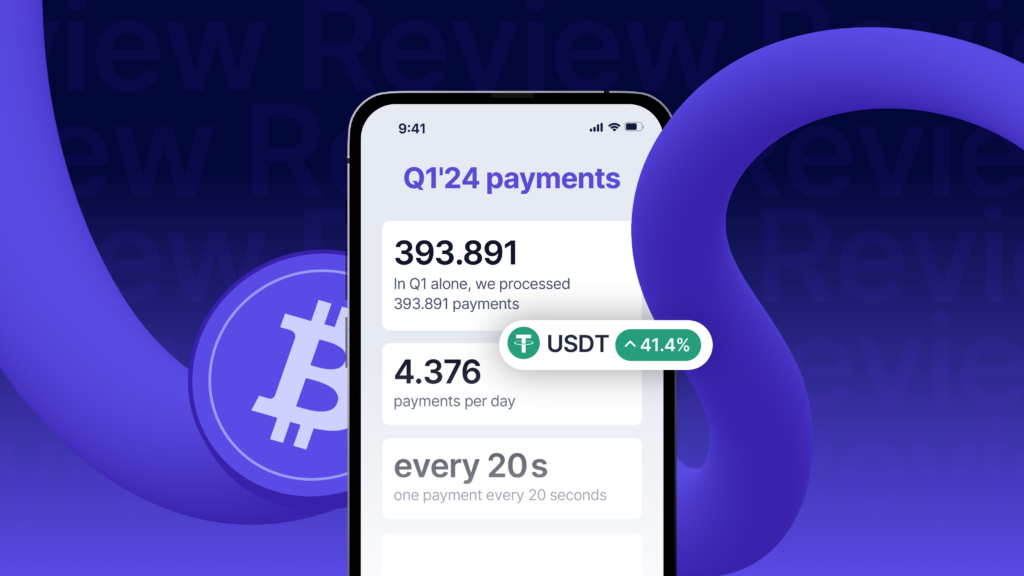
What Are Stablecoins? The Benefits & Risks for Businesses

Stablecoins have emerged as a pivotal element in the cryptocurrency ecosystem, offering a unique blend of traditional financial stability and the innovative capabilities of blockchain technology.
While traditional cryptocurrencies like Bitcoin and Ethereum have revolutionized digital finance, they often face challenges such as high transaction fees, price volatility, and slower processing times.
Stablecoins were introduced to mitigate these issues, providing a more predictable and efficient medium of exchange.
This comprehensive guide delves into what stablecoins are, their various types, and the potential benefits and drawbacks for businesses.
Additionally, we will explore the most popular stablecoins – USDT, USDC, and DAI – and how CoinGate facilitates their acceptance for payments.
What is Stablecoin?
More and more people are asking the question, what is a stablecoin?
Stablecoins are a type of cryptocurrency designed to minimize price volatility.
Unlike typical cryptocurrencies like Bitcoin or Ethereum, which can experience significant price fluctuations, stablecoins aim to maintain a stable value.
How Do Stablecoins Maintain the Same Value?
Stablecoins achieve their stability by being pegged to a reserve of assets, such as fiat currency (e.g., the US dollar), commodities (e.g., gold), or even other cryptocurrencies.
In most cases, these stablecoins can be exchanged back to the assets they are pegged to, reinforcing trust in their value and stability. This redeemability ensures that stablecoins maintain a predictable price, unlike traditional cryptocurrencies that experience significant fluctuations.
Unlike Bitcoin or Ethereum, stablecoins are not mined. Instead, their supply is dynamically adjusted through mechanisms such as minting and burning.
When demand increases, new stablecoins are issued (minted) to maintain the peg, while when demand decreases, excess coins are removed from circulation (burned).
This is how stablecoins keep the value aligned with the underlying asset, ensuring a reliable and stable medium of exchange.
What Are the Types of Stablecoins?
There are five primary types of stablecoins, each with its own mechanism for maintaining price stability:
- Fiat Backed Stablecoins
- Crypto-Collateralized Stablecoins
- Algorithmic Stablecoins
- Commodity-backed Stablecoins
- Basket-pegged Stablecoins
Fiat-Backed Stablecoins
Fiat-collateralized stablecoins are backed by a reserve of fiat currency, such as the U.S. dollar or euro. For every stablecoin issued, an equivalent amount of fiat currency is held in reserve by a central entity, ensuring that the stablecoin maintains a 1:1 peg with the underlying asset. This type of stablecoin is the most straightforward and widely used due to its stability and trustworthiness.
Pros: High stability, widely accepted, easy to redeem for fiat
Cons: Requires trust in a central entity, subject to regulation

Examples:
- USDT (Tether): One of the oldest and most widely recognized fiat-collateralized stablecoins. It is pegged to the U.S. dollar and backed by reserves of cash and cash equivalents.
- USDC (USD Coin): Similar to USDT, USDC is pegged to the U.S. dollar and backed by fully reserved assets, with regular attestations of reserves provided by third-party auditors. CoinGate also supports USDC payments on various networks.
Crypto-Collateralized Stablecoins
Crypto-backed stablecoins are secured by other cryptocurrencies rather than fiat. Due to the volatility of digital assets, these stablecoins typically require over-collateralization (e.g., depositing $150 worth of crypto for every $100 issued in stablecoins) to absorb price fluctuations.
Pros: Decentralized, does not rely on traditional banking systems
Cons: Volatility risk, requires over-collateralization
Example:
- DAI: A well-known example of a crypto-collateralized stablecoin, managed by the MakerDAO protocol. DAI is backed by various cryptocurrencies held in smart contracts, allowing for decentralized issuance and stability. DAI is also one of the stablecoins that CoinGate merchants accept for payments.
Algorithmic Stablecoins (Seigniorage-style)
Algorithmic stablecoins maintain their peg without any collateral, relying instead on smart contracts and predefined rules to regulate supply and demand. This approach is often referred to as seigniorage-style stabilization, a concept borrowed from traditional monetary policy, where a central authority adjusts the money supply to maintain value.
In simple terms, algorithmic stablecoins work like this:
- When the stablecoin’s price rises above its peg (e.g., above $1), new coins are minted and introduced into circulation to increase supply, pushing the price back down.
- When the price falls below its peg (e.g., below $1), the system reduces supply by “burning” (removing) some stablecoins, encouraging price recovery.

This mechanism attempts to balance supply and demand dynamically. However, unlike fiat-backed or crypto-backed stablecoins, algorithmic stablecoins do not have underlying assets supporting their value, making them inherently riskier.
Pros: Fully decentralized, scalable, does not require collateral
Cons: High risk of depegging, dependent on market confidence, vulnerable to extreme volatility
One of the biggest challenges of algorithmic stablecoins is maintaining trust. If market participants lose confidence in the algorithm’s ability to stabilize the price, a death spiral can occur—where declining prices trigger mass sell-offs, making recovery impossible.
Examples:
A famous example is TerraUSD (UST), an algorithmic stablecoin that was pegged to the US dollar. It used its sister token, LUNA, to stabilize the peg through a burn/mint mechanism. However, in May 2022, UST lost its peg due to a sharp drop in demand and external market conditions. The system could not restore the peg, leading to a catastrophic collapse of both UST and LUNA, wiping out billions in market value.
Despite this, algorithmic stablecoins continue to be explored as an alternative model for decentralized finance. However, due to their risks, businesses and investors should approach them with caution.
Commodity-Backed Stablecoins
Commodity-backed stablecoins are supported by reserves of physical commodities, such as gold, silver, or other precious metals. Each stablecoin issued corresponds to a specific amount of the commodity, ensuring that the stablecoin’s value is pegged to the real-world market price of the underlying asset. This type of stablecoin provides intrinsic value and stability due to its tangible backing.
Pros: Backed by real assets, retains intrinsic value
Cons: Limited scalability, storage and security concerns for the reserves
Examples:
- PAX Gold (PAXG): A widely recognized gold-backed stablecoin. Each PAXG token represents one fine troy ounce of gold held in secure, insured vaults.
- Tether Gold (XAUT): A commodity-backed stablecoin where each XAUT token is pegged to one troy ounce of gold, stored in a Swiss vault. This stablecoin allows users to trade and own gold digitally, benefiting from its stability and intrinsic value.
Basket-Pegged Stablecoins
Some stablecoins derive their value from a basket of assets rather than a single reserve currency or commodity. These stablecoins offer diversification and reduce reliance on a single asset. A basket-pegged approach can include a combination of fiat currencies, cryptocurrencies, or commodities, improving resilience against market fluctuations.
Pros: More stable than single-asset-pegged stablecoins, diversified risk
Cons: Complex management, regulatory uncertainty
These different types of stablecoins offer varying benefits and trade-offs, allowing users and businesses to choose the most suitable option based on their needs.
Simplifying the Stablecoin Payment Process
Stablecoins offer a unique blend of stability and innovation, making them an attractive option for businesses looking to integrate cryptocurrency into their payment systems.
At CoinGate, nearly all merchants accept crypto payments in stablecoins. In fact, in Q1 2024, USDT dominated the payments landscape, accounting for 41.4% of all transactions, as outlined in our quarterly report.

By supporting USDT, USDC, and DAI across multiple blockchain networks, we’re able to provide the most flexible, sophisticated payment method that every merchant can appreciate.
For example, at Ondato, a digital identity management system that accepts crypto payments through CoinGate, USDT payments account for 94.4% of all cryptocurrency payments they collect! You can learn more about it in this case study.
In both Q2 and over the last year, stablecoins have solidified their position as a preferred payment method even further. USDC payments in Q2’24 increased by 24% if we compare to Q1’24, and 94% year over year.
DAI payments also rose by 9% compared to Q1’24. They also rose by 37% compared to Q2’23.
However, USDT still leads the pack and accounts for 34.2% of all orders in Q2’24, mostly on the TRON network. Read more about stablecoin performance in our H1 2024 payments review.

In a yearly 2024 report, which sums up all the data gathered throughout 2024, we highlight that a staggering 35.5% of all crypto payments made through CoinGate are attributed to stablecoin transactions.
Businesses can select the network that best aligns with their operational needs, whether it’s the Ethereum network with its robust smart contract capabilities or emerging networks like TRON offering lower transaction fees and faster processing times.

This multi-network support is important for accommodating the requirements of modern businesses, allowing them to leverage the advantages of stablecoins – such as price stability, fast transactions, lower fees, global accessibility, and enhanced security – at the same time as mitigating potential drawbacks like regulatory uncertainty and technological barriers.
What Are The Benefits of Stablecoins?
Accepting stablecoins as a payment method offers several significant advantages for businesses:
Price Stability
The primary benefit of stablecoins is their ability to maintain a stable value.
Unlike traditional cryptocurrencies, which can experience significant price fluctuations, stablecoins are pegged to stable assets like fiat currencies or commodities. This stability makes them an attractive option for businesses looking to avoid the financial uncertainty and risk associated with volatile cryptocurrencies.
By using stablecoins, businesses can confidently price their goods and services without worrying about sudden changes in value that could affect their bottom line.
Fast Transactions
Stablecoin transactions can be processed quickly, often within minutes, compared to traditional banking systems which may take several days to settle, especially for international transactions.
This speed can improve cash flow management, allowing businesses to receive payments faster and increase operational efficiency.
Faster transaction times also mean improved customer satisfaction, as clients and customers receive immediate confirmation of their payments.

Lower Transaction Fees
Transaction fees for stablecoins are generally lower than those for credit cards and other traditional payment methods.
Credit card processing fees can range from 2% to 4% per transaction, which can add up significantly for businesses with high transaction volumes.
In contrast, stablecoin transactions typically incur minimal fees, reducing overall payment processing costs.
Global Accessibility
Stablecoins provide a way for businesses to engage with international customers without the need for currency conversion. Traditional cross-border payments often involve multiple intermediaries, resulting in high fees and long processing times.
On the other hand, Stablecoins can be sent and received globally with ease, facilitating seamless international trade.
Transparency and Security
Blockchain technology ensures that all stablecoin transactions are transparent and secure.
Every transaction is recorded on a public ledger, making it traceable and auditable. This transparency reduces the risk of fraud and chargebacks, providing businesses with greater confidence in their payment processes.
Additionally, the security features of blockchain, such as cryptographic encryption and decentralized verification, protects against unauthorized access and tampering, safeguarding both the business and its customers’ financial data.
What Are The Disadvantages of Stablecoins?
Despite their advantages, stablecoins also present some challenges that businesses need to consider:
Regulatory Uncertainty
The regulatory environment for stablecoins is still evolving. Governments and financial authorities around the world are in the process of developing and implementing regulations for digital currencies, including stablecoins.
New regulations could affect how stablecoins are used, taxed, or reported.
For example, in the summer of 2024, Circle, a global financial technology firm and the issuer of USDC and EURC stablecoins, has become the first global stablecoin issuer to achieve compliance with the European Union’s Markets in Crypto-Assets (MiCA) regulatory framework, finally bringing clarity to the market.
Centralization Risks
Fiat backed stablecoins are backed by traditional currency reserves and managed by central organizations.
This centralization means businesses must trust that the issuer has the claimed reserves and can redeem the stablecoins when needed.
If the issuer fails to maintain these reserves or goes bankrupt, the stablecoin’s value could be at risk. Additionally, centralized control can lead to transparency issues and potential manipulation, which may undermine trust in the stablecoin.
Technological Barriers
Implementing stablecoin payment systems requires technical knowledge and integration with existing financial systems.
This process can be complex and resource-intensive, particularly for businesses without a strong technological foundation. Companies need to invest in technology infrastructure, staff training, and cybersecurity measures to ensure smooth and secure transactions.
However, by implementing CoinGate payment processing solution, you can bypass all the risks associated with stablecoins.
Why Would Anyone Use a Stablecoin to Shop?
While stablecoins are often associated with crypto trading and payments for businesses, they also offer significant advantages for everyday shoppers.
Discover merchants that accept Bitcoin, crypto and stablecoin payments in our merchant directory!
Unlike traditional cryptocurrencies, which can experience extreme volatility, stablecoins provide a reliable, predictable value that makes them a practical choice for online and international purchases.
Here are some key reasons why consumers may prefer stablecoins when shopping:
Protection from Inflation
In regions with unstable national currencies, high inflation can erode purchasing power, making it difficult for consumers to save or plan for future expenses.
Stablecoins pegged to strong global currencies, such as the U.S. dollar, allow people to store value in a more stable asset without needing a bank account in another country.
By using stablecoins, consumers in inflation-prone economies can protect their wealth and make purchases without worrying about their local currency rapidly losing value.
Budget-Friendly Cross-Border Shopping
International shopping often comes with high currency conversion fees and unpredictable exchange rate fluctuations.
Stablecoins eliminate the need for costly intermediaries by allowing shoppers to pay in a universally accepted digital currency without losing money on exchange rates or extra bank fees.
This makes stablecoins an attractive payment option for global e-commerce transactions, benefiting both shoppers and merchants.
Financial Inclusion
Millions of people worldwide lack access to traditional banking services, preventing them from making online purchases or participating in the digital economy.
Stablecoins offer a solution by allowing anyone with an internet connection to store, send, and spend money without needing a bank account.
This is particularly useful for unbanked individuals who rely on mobile wallets and cryptocurrency networks for financial transactions.
Improved Privacy
Stablecoin transactions offer more privacy than traditional payment methods, such as credit cards, which often require personal information and can be tracked by financial institutions or third parties.
While stablecoin payments are recorded on the blockchain, they do not necessarily expose identifiable personal details, providing consumers with an added layer of anonymity and security when shopping online.
By offering stability, accessibility, cost-efficiency, and privacy, stablecoins are increasingly becoming a preferred payment method for consumers worldwide.
CoinGate enables businesses to accept stablecoins seamlessly, opening up new opportunities for both merchants and shoppers in the digital economy.
Stablecoin Regulation
Stablecoin regulation encompasses government and institutional efforts to oversee the issuance, use, and management of stablecoins—digital assets designed to maintain a stable value by being pegged to assets like fiat currencies or commodities.
Regulating stablecoins is crucial to ensure financial stability, protect consumers, prevent illicit activities, and integrate these digital assets into the broader financial system responsibly.
Regulatory Landscape in the United States
In the United States, the regulatory environment for stablecoins is evolving. The Stablecoin Transparency of Reserves and Uniform Safe Transactions (Stablecoin TRUST) Act of 2022 was introduced to establish a clear framework for payment stablecoins. This bill proposes that only certain entities, such as insured depository institutions and licensed non-bank entities, can issue stablecoins, subject to specific disclosure and reserve requirements.
Additionally, the Federal Reserve plays a significant role in overseeing stablecoin activities, especially concerning their potential impact on monetary policy and financial stability. The Fed’s involvement ensures that stablecoin arrangements do not pose systemic risks to the economy.
Regulatory Landscape in the European Union
The European Union has proactively addressed stablecoin regulation through the Markets in Crypto-Assets (MiCA) Regulation, which was enacted in June 2023 and became fully applicable in December 2024. MiCA provides a comprehensive framework for crypto-assets, including stablecoins, aiming to protect consumers and ensure financial stability. It categorizes stablecoins into two types:
- Electronic Money Tokens (EMTs): Stablecoins backed by a single fiat currency, treated similarly to electronic money.
- Asset-Referenced Tokens (ARTs): Stablecoins backed by a basket of assets, which may include multiple currencies, commodities, or other assets.
MiCA imposes strict requirements on stablecoin issuers, including the need for authorization, adherence to governance standards, and maintenance of sufficient reserves. These measures aim to mitigate risks associated with stablecoins and foster innovation within a regulated environment. You can read our article about MiCA regulations to understand what it means for CoinGate and its clients.
As a result, cryptocurrency payment processors, including us, are limiting support for stablecoins like USDT and DAI.

Challenges in Regulating Stablecoins
Regulating stablecoins presents several challenges:
- Technological Complexity: The rapid evolution of blockchain technology can outpace regulatory frameworks, making it difficult for authorities to keep up.
- Global Nature: Stablecoins operate across borders, complicating jurisdictional authority and requiring international cooperation for effective regulation.
- Diverse Structures: The varying designs of stablecoins, including differences in collateralization and governance, necessitate tailored regulatory approaches.
- Balancing Innovation and Risk: Regulators must strike a balance between fostering financial innovation and mitigating potential risks to consumers and the financial system.
As stablecoins continue to grow in popularity and use, developing robust regulatory frameworks that address these challenges is essential to ensure their safe integration into the global financial ecosystem.
Altcoins vs Stablecoins
The cryptocurrency market consists of various types of digital assets, with altcoins and stablecoins being two of the most commonly discussed categories. While both belong to the broader crypto space, they serve vastly different purposes and exhibit distinct characteristics.
Altcoins: Innovation & Volatility
Altcoins, or “alternative coins,” refer to all cryptocurrencies other than Bitcoin—including Ethereum, Solana, and Cardano. These digital assets focus on innovation and technological advancements, enabling features like smart contracts, decentralized applications, and new consensus mechanisms.
However, altcoins are typically highly volatile. Their prices fluctuate based on market demand, speculation, and network upgrades. While this volatility offers investment opportunities, it makes them less reliable for everyday transactions.
Stablecoins: Predictability & Practicality
Stablecoins, on the other hand, prioritize price stability over innovation. Pegged to stable assets such as the U.S. dollar, gold, or a basket of assets, they offer a predictable store of value, making them ideal for payments, remittances, and preserving wealth in unstable economies.
Unlike altcoins, stablecoins are not designed for price speculation. Instead, they serve as a bridge between traditional finance and crypto, allowing users to transact in digital currency while avoiding extreme price swings.
How They Complement Each Other
While altcoins drive technological progress and investment opportunities, stablecoins focus on usability and financial stability. Both serve distinct but complementary roles in the crypto ecosystem—altcoins power innovation, while stablecoins facilitate real-world transactions.
At CoinGate, we support both stablecoins and altcoins, enabling businesses and individuals to leverage the strengths of each to meet their unique financial needs.
CBDC vs Stablecoins
With time, two major players have emerged: Central Bank Digital Currencies (CBDCs) and stablecoins. While both aim to provide a more efficient digital payment system, they differ significantly in issuance, purpose, and control.
Key Differences
- Issuance & Control:
- CBDCs are issued and controlled by central banks, functioning as digital versions of fiat currency.
- Stablecoins are privately issued and pegged to assets like fiat, commodities, or crypto reserves.
- Regulation & Oversight:
- CBDCs operate under strict regulatory frameworks and government oversight.
- Stablecoins face regulatory uncertainty, as they are issued by private entities or decentralized protocols.
- Use Cases & Adoption:
- CBDCs are designed to enhance financial inclusion, enable faster cross-border payments, and improve monetary policy execution.
- Stablecoins are widely used in crypto markets for trading, payments, and preserving value in volatile economies.
Challenges & Considerations
- CBDCs & Centralization Concerns: While they offer regulatory security, CBDCs may raise privacy concerns due to government control over financial transactions.
- Stablecoins & Regulatory Uncertainty: Despite their flexibility and widespread use, stablecoins face unclear and evolving regulations that may impact their adoption and stability.
Both CBDCs and stablecoins play crucial roles in the digital financial landscape—CBDCs focus on government-backed stability and inclusion, while stablecoins offer decentralized alternatives for seamless transactions.
Overview and Comparison of Popular Stablecoins
USDT (Tether)
Launched in 2014, Tether (USDT) is one of the earliest and most widely used stablecoins in the cryptocurrency market.
It is pegged to the U.S. dollar, meaning each USDT token is intended to be equivalent to one US dollar. Tether achieves this peg by holding reserves of fiat currency and other assets.
Tether’s primary strength lies in its high liquidity and widespread acceptance across cryptocurrency exchanges.
It is one of the most traded stablecoins, making it a convenient option for traders and businesses looking for stability in their transactions. Its extensive use in the crypto ecosystem provides reliable access to stable digital assets, facilitating seamless transitions between volatile cryptocurrencies and stable fiat value. However, in EU region, many are delisting it due to changing regulations.
USDC (USD Coin)
USD Coin (USDC) is a fully reserved stablecoin pegged to the U.S. dollar.
It was launched by the Centre consortium, which includes major financial players Coinbase and Circle. USDC aims to provide a transparent and regulated stablecoin option in the digital assets space.
One of USDC’s key strengths is its commitment to transparency and regulatory compliance. The stablecoin undergoes regular audits and transparency reports, enhancing trust and credibility among users and regulators.
This rigorous oversight ensures that each USDC token is backed by an equivalent amount of U.S. dollars, providing confidence in its value and stability. CoinGate also supports USDC on Solana for payments and other services.
DAI
DAI is a decentralized stablecoin managed by the MakerDAO protocol.
Unlike USDT and USDC, DAI is not pegged to the U.S. dollar through a central reserve of fiat currency.
Instead, it is backed by a diversified pool of cryptocurrencies held in smart contracts, making it a unique player in the stablecoin market.
DAI’s decentralization is a significant advantage, as it reduces counterparty risk and enhances transparency.
Since no central entity controls DAI, the risk of mismanagement or insolvency is minimized. The decentralized nature of DAI also aligns with the broader ethos of blockchain technology, promoting trustless and transparent financial systems.
Are stablecoins the future of cryptocurrencies?
Stablecoins are relatively new in the blockchain industry, and we are yet to explore their full potential and use cases. Even though we already can reap the benefits of currently operating stablecoins, we will surely see a broader variety of them emerging in the upcoming years.
Ready To Take Advantage of Stablecoins?
CoinGate simplifies the stablecoin payment process by supporting popular stablecoins like USDT, USDC, and DAI across multiple networks, making it easier for businesses to integrate and benefit from these digital assets while also managing traditional fiat currencies. Here’s some examples of merchants accepting stablecoin payments like USDT and USDC.
If you’re looking to take advantage of stablecoin payments and other benefits that they bring, consider signing up for a CoinGate account
FAQ About Stablecoins
Why are stablecoins better than fiat?
Stablecoins offer faster, borderless, and lower-cost transactions compared to traditional fiat money. They also provide access to decentralized finance (DeFi) and crypto-based payment solutions like those offered by CoinGate, enabling seamless global commerce without reliance on banks.
How do stablecoins make money?
Stablecoin issuers generate revenue through various methods, including:
- Interest on fiat reserves (when stablecoins are backed by cash or cash-equivalents).
- Transaction fees on conversions and withdrawals.
- DeFi lending and staking for yield generation.
What is the difference between cryptocurrency and stablecoin?
A cryptocurrency (e.g., Bitcoin, Ethereum) operates with fluctuating market prices based on supply and demand. A stablecoin, on the other hand, is pegged to an asset like fiat or commodities, reducing volatility and making it a reliable medium of exchange.
Do stablecoins carry any risks?
Yes, stablecoins come with risks, including:
- Counterparty risk (trusting the issuer to maintain reserves).
- Regulatory risk (government restrictions or regulations).
- Depegging risk (instances where a stablecoin loses its fixed value due to liquidity issues or market instability).
However, CoinGate is built to mitigate these risks effectively.
How safe is stablecoin?
The safety of a stablecoin depends on its backing and transparency. Fiat-backed stablecoins like USDC and USDT generally have high liquidity and regulatory compliance, making them safer options. CoinGate enables merchants to accept trusted stablecoins, ensuring secure transactions.
Has USDC ever lost its peg?
Yes, USDC briefly lost its $1 peg in March 2023 when Silicon Valley Bank (SVB) collapsed, as a portion of its reserves was held in the bank. However, after government intervention, USDC quickly regained its peg, highlighting the importance of reserve management.
Is it safe to keep money in stablecoins?
Stablecoins are generally safe for short-term holding and transactions.
What is the risk of collateral backing of stablecoins?
The biggest risk is insufficient or mismanaged reserves. If a stablecoin issuer fails to maintain 1:1 reserves, it could lead to a depegging event, causing losses for holders. Transparency and third-party audits help mitigate this risk.
What was the first stablecoin?
Tether (USDT) was the first stablecoin, launched in 2014 as a fiat-backed digital asset pegged to the U.S. dollar. Since then, many other stablecoins have entered the market, offering various collateral models.
Where can I buy stablecoins?
Stablecoins can be purchased on crypto exchanges, DeFi platforms, and payment gateways like CoinGate, which enables businesses and individuals to transact using stablecoins.
How to buy stablecoin?
- The easiest way to buy stablecoins like USDC or USDT is with a credit card. However, you can also buy stablecoins on exchanges.
Accept crypto with CoinGate
Accept crypto with confidence using everything you need in one platform.

